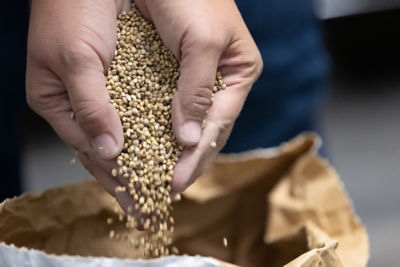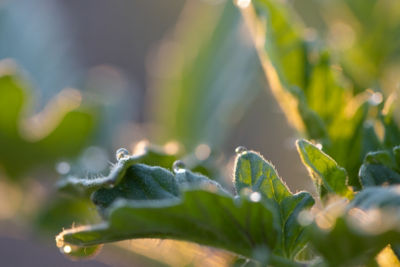Click here to download a PDF version of this spotlight.
» Tipburn of lettuce is a non-infectious condition believed to be caused by a localized calcium deficiency in specific leaf tissues.
» Tipburn symptoms include brown necrotic areas along the edges of inner lettuce leaves.
» Selecting lettuce varieties that are less susceptible to tipburn and providing appropriate crop input levels can help reduce problems with tipburn on lettuce.
Tipburn is an abiotic (non-infectious, physiological) disorder of lettuce that can develop on the tips and edges of young leaves growing near the shoot tip. Tipburn is believed to result from a calcium deficiency localized to that specific tissue even when there are adequate amounts of calcium in other parts of the plant. This disorder is similar to blossom end rot on tomatoes, peppers, and eggplants.1,2,3 Symptoms of tipburn include the development of necrotic (dead) tan to brown areas on the edges of inner leaf blades of open-leaf varieties and the enclosed leaves of crisp-head lettuce varieties (Figure 1). The condition usually only affects a small area of the leaf. Initially, there is a darkening of the veins in the affected tissue, and the area around the veins may lack turgor. The affected tissue eventually collapses and becomes necrotic.2 Damage to the leaf edges can limit leaf expansion and result in growth deformations. The damaged tissues can reduce yields and lower product quality. Even small amounts of tipburn can make a head of lettuce unmarketable.
Tipburn can occur on all lettuce types, and it usually appears shortly before harvest maturity in field-grown lettuce. It can occur earlier on greenhouse-grown lettuce. With crisp-head and some romaine varieties, tipburn may not be noticed until harvest. Many packing companies will not buy or distribute lettuce when more than five percent of the heads have tipburn symptoms, and some packing companies scout fields before harvest and may reject fields with relatively low levels of the disorder.2,4
 Figure 1. (A) Tipburn symptoms developing on the innermost, expanding leaves on a lettuce head. (B) Necrotic tissue on the edge of a leaf blade causing leaf deformation.
Figure 1. (A) Tipburn symptoms developing on the innermost, expanding leaves on a lettuce head. (B) Necrotic tissue on the edge of a leaf blade causing leaf deformation.
THE CAUSE OF TIPBURN
Lettuce plants use calcium (Ca) for several things. Ca is used as part of the cell wall structure, including in forming pectin, the substance that helps “glue” cells together. Ca is also involved in cell membrane function, cell-to-cell signaling, and maintaining an ion charge balance within the cell. The symptoms seen with tipburn appear to be related to the collapse of cell walls. However, the specific role of Ca in the disorder is poorly understood.2,4
The uptake of Ca from the soil and the transportation of Ca within the plant is usually a passive process associated with the uptake of water and minerals by the root system and translocation upward in the xylem (water-conducting tissue) of the plant. Ca taken up by the roots moves into the stele (root vascular tissue) and then moves unidirectionally upward in the xylem to the leaves. The plant’s transpiration rate usually regulates the uptake and movement of water and Ca. Rapidly transpiring tissues (outer leaves) receive more water and thus more Ca than tissues with lower transpiration rates (inner leaves). Ca is considered a relatively immobile element within the plant. So, once it moves into the tissue through water flow, it is not able to be relocated to another area of the plant as can be done with other nutrients, such as nitrogen.2,4
Any set of conditions that reduce the movement of Ca to tissues during times of growth can result in tipburn. When environmental conditions (temperature, light intensity, nutrient levels) favor rapid growth, the expanding leaf cells need a constant supply of Ca to develop correctly. Conditions that alter the transpiration rate can change the Ca distribution balance and result in tipburn.
Under certain conditions, such as high temperatures, low relative humidity, and high windspeeds during the day, the rate of transpiration in the outermost leaves of the lettuce plant may be substantially higher than the rate from the innermost leaves of leafy types of lettuce (e.g., romaine) or the enclosed leaves of crisp-head types. This will result in more Ca flowing to the outer leaves than the inner, protected leaves, eventually resulting in lower Ca levels in those inner leaves.4 However, at night, when plants are not photosynthesizing, they usually close their stomates and reduce the transpiration rate.
Water and Ca can still move up into the plant at night through a process called root pressure flow. In this process, root cells actively move mineral ions (including Ca ions) from the soil solution into the xylem and other inner root cells. The increased ion concentration in the root tissue causes water to be pulled into the root, which then pushes water (and nutrients) up into the leaves. Since this process does not result from transpiration, Ca is delivered to inner and outer leaves more evenly. It has been shown that environmental conditions that disrupt root pressure flow at night can result in symptoms of tipburn on the inner leaves. This can include dry, windy conditions at night that cause water to evaporate from the outer leaves, overcoming the root pressure flow process.5,6
Another circumstance that can lead to tipburn is foggy or cloudy conditions with high relative humidity levels and little air movement during the day. These conditions reduce the overall transpiration rate, limiting the amount of Ca being translocated into the leaves. The innermost, rapidly growing leaves are most affected by the lack of locally available Ca. This is especially problematic during the last six to ten days before harvest and after the tops of crisp-head types have closed.1,2
MANAGEMENT
Crop inputs (water and fertilizer) should be appropriate for the lettuce type, time of year, and growth stage of the crop. Avoid over-fertilization, as this can promote rapid growth and lead to increased levels of tipburn.2
Foliar applications of Ca fertilizer may help lower tipburn levels in some situations, but studies have shown variation in the effectiveness of such applications. The Ca needs to be applied directly to the leaves at risk for tipburn, as Ca will not be translocated from the outer to the inner leaves. So, applications are not likely to reduce tipburn on closed-head varieties, though they may help on open-head varieties if applied before tipburn symptoms appear.1,2 Ca fertilizer applied through the drip system will likely be ineffective in managing tipburn.
Growers can choose lettuce varieties that are less susceptible to tipburn. There are documented differences in tipburn susceptibility among varieties of all lettuce types, but no variety is considered completely resistant to tipburn.1,2,3 Open-top (leafy) varieties tend to be less susceptible under normal growing conditions because the differences in transpiration rates from inner and outer leaves are smaller than with closed-top varieties. However, crisp-head types tend to be less susceptible than romaine types because breeders have put more effort into selecting resistance to tipburn in crisp-head types. Tipburn susceptibility is not correlated with the yield potential varieties. So, high-yielding varieties are not necessarily more prone to tipburn than lower-yielding varieties. Susceptibility is also not associated with leaf color.7 The susceptibility of varieties to tipburn does depend on the environmental conditions present, and a variety that shows resistance in some environments may be more susceptible in others.3,4
In bulk-harvested lettuce used for salad processing, affected leaves can sometimes be trimmed or removed to eliminate the symptomatic tissues.2
For lettuce grown in protected culture systems (greenhouses), tipburn can often be managed by modifying the daytime and nighttime growing environments. Because tipburn is more likely to occur in conditions that promote fast growth but limit transpiration (high light, nutrient, and humidity levels), limiting growth by providing less light and lowering humidity levels and temperatures can help prevent tipburn. Increasing airflow to provide good air movement can also be effective. Increasing humidity levels at night to help promote increased root pressure flow may also help manage tipburn.2,4,8
SOURCES
1 Smith, R., Hartz, T., and Hays, R. 2011. Overview of tipburn of lettuce. Salinas Valley Agriculture. UC ANR. August 25, 2011.
2 Hayes, R. 2017. Tipburn. In Subbarao, K., Davis, R., Gilbertson, R., and Raid, R., Eds., Compendium of Lettuce Diseases and Pests, Second Edition. American Phytopathological Society.
3 Van Vranken, R. 2023. Timely reminder conditions a perfect storm for lettuce tip burn. Rutgers Cooperative Extension. Plant & Pest Advisory, September 27, 2023.
4 Ertle, J.M. 2023. Tipburn management through controlled environment for indoor vertical farm lettuce production. PhD. Dissertation, The Ohio State University.
5 Palzkill, D.A. and Tibbitts, T.W. 1977. Evidence that root pressure flow is required for calcium transport to head leaves of cabbage. Plant Physiol. 60(6):854-6.
6 Lopez, F.B. and Barclay, G.F. 2017. Driving forces for water flow from roots to leaves. In Badal, S. and Delgoda R. Eds. Pharmacognosy: Fundamentals, Applications, and Strategies. Elsevier Inc.
7 Kubota, C. and Ertle, J. 2023. Lettuce tipburn sensitivity trial – preliminary results.
http://Bit.ly/egro-lettuce-tipburn.
8 Kubota, C., G. Papio, and J. Ertle. 2023. Technological overview of tipburn management for lettuce (Lactuca sativa) in vertical farming conditions. Acta Horticulturae 1369. ISHS 2023. DOI 10.17660/ActaHortic.2023.1369.8.
Websites verified 2/8/2024
ADDITIONAL INFORMATION
Performance may vary, from location to location and from year to year, as local growing, soil and environmental conditions may vary. Growers should evaluate data from multiple locations and years whenever possible and should consider the impacts of these conditions on their growing environment. The recommendations in this article are based upon information obtained from the cited sources and should be used as a quick reference for information about vegetable production. The content of this article should not be substituted for the professional opinion of a producer, grower, agronomist, pathologist and similar professional dealing with vegetable crops.
BAYER GROUP DOES NOT WARRANT THE ACCURACY OF ANY INFORMATION OR TECHNICAL ADVICE PROVIDED HEREIN AND DISCLAIMS ALL LIABILITY FOR ANY CLAIM INVOLVING SUCH INFORMATION OR ADVICE.
5911_364194 Published 02/26/2024
Bayer,




